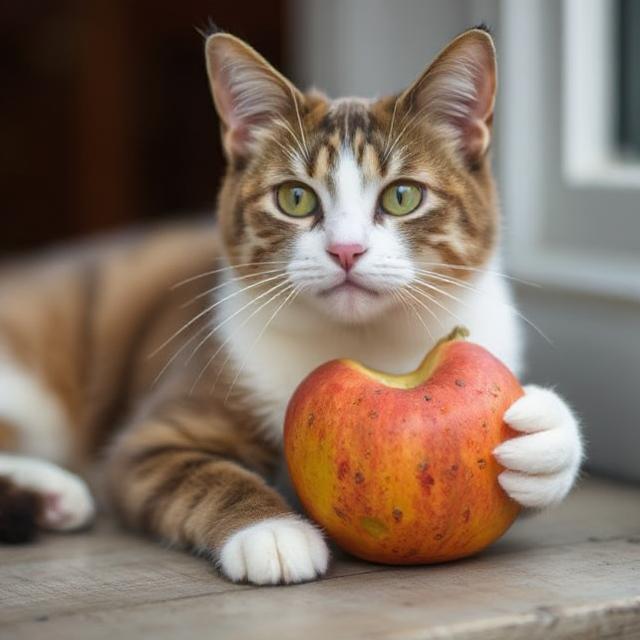What Fruits Cats Can Eat Safely
What Fruits Cats Can Eat Safely: A Complete Guide for Pet Owners
What fruits cats can eat safety. As cat owners, we often want to share everything we love with our furry friends — including our favorite fruits. But before offering that juicy slice of watermelon or a piece of banana to your cat, it’s important to ask: Can cats eat fruit safely?
The short answer is yes, some fruits are safe for cats in moderation, while others can be toxic or harmful. This guide will walk you through the best fruits cats can eat safely, those to avoid completely, and tips for feeding fruit the right way.
Can Cats Eat Fruit? Understanding a Cat’s Diet
Cats are obligate carnivores, which means their bodies are designed to get nutrients primarily from meat. Unlike humans or even dogs, cats don’t need fruits or vegetables in their diet. Their digestive systems aren’t built to process plant-based foods efficiently. What fruits cats can eat safety
That said, a small piece of fruit occasionally can be a safe treat. Fruits can offer hydration, vitamins, and a bit of natural sweetness — though cats can’t actually taste sweetness the way humans can. The key is moderation and choosing the right fruits. What fruits cats can eat safety
Safe Fruits Cats Can Eat
Below are some fruits that are generally safe for cats to consume in small amounts. Always remove seeds, pits, and rinds before offering any fruit.
1. Apples
Yes, cats can eat apples — but with caution.
Apples are packed with vitamins A and C and provide a small fiber boost. However, apple seeds and cores contain cyanide, which is toxic to cats. Always remove the seeds and core before giving a small piece of peeled apple to your cat. What fruits cats can eat safety
How to serve:
-
Offer a tiny slice (no larger than a fingernail).
-
Make sure it’s plain — no sugar, caramel, or seasoning.
2. Bananas
Bananas are one of the safest fruits for cats in moderation. They contain potassium, fiber, and natural carbohydrates. However, too much banana can lead to constipation or weight gain because of the high sugar content. What fruits cats can eat safety
How to serve:
-
A small slice once in a while is enough.
-
Avoid feeding daily — it’s a treat, not a meal replacement.
3. Blueberries
Blueberries are often called a superfood for humans — and cats can safely enjoy them too! They contain antioxidants, fiber, and vitamin C, which may support a cat’s immune system. What fruits cats can eat safety
Fun fact: Some cat treats and premium cat foods actually include blueberry powder for added nutrition. What fruits cats can eat safety
How to serve:
-
Offer 1–2 blueberries as an occasional snack.
-
You can serve them fresh or frozen (a cooling treat in summer).
4. Watermelon
Watermelon is about 90% water, making it a great hydrating snack for cats — especially in hot weather. Most cats enjoy the texture of watermelon, but avoid feeding the rind or seeds, as they can cause digestive issues. What fruits cats can eat safety
How to serve:
-
A seedless cube of watermelon is ideal.
-
Serve chilled for a refreshing summer treat.
5. Strawberries
Strawberries are safe for cats and can be a fun treat due to their soft texture. They’re high in vitamin C and antioxidants. However, they’re also high in natural sugar, so moderation is key. What fruits cats can eat safety
How to serve:
-
Cut the strawberry into tiny pieces.
-
Only give a small portion occasionally.
6. Cantaloupe and Honeydew
Melons like cantaloupe and honeydew are safe and often favored by cats for their smell. They’re rich in vitamin A and C and help with hydration. What fruits cats can eat safety
How to serve:
-
Offer a small cube (seedless and rind-free).
-
Serve fresh; avoid flavored or canned melon.
7. Mango
Mango is another fruit cats can eat safely in moderation. It’s loaded with vitamins A, B6, and C. Cats usually enjoy its soft, juicy texture. What fruits cats can eat safety
How to serve:
-
Remove the peel and pit completely.
-
Offer a few small cubes as an occasional reward.
8. Pears
Pears can be safe for cats when offered properly. They’re full of fiber and vitamin C. However, pear seeds contain cyanide, like apple seeds, so remove all seeds before serving. What fruits cats can eat safety
How to serve:
-
Slice a small piece of peeled pear.
-
Avoid canned pears in syrup, as sugar can upset your cat’s stomach.
9. Pineapple
Fresh pineapple is safe in small quantities, but never feed canned pineapple, which is often soaked in sugary syrup. Pineapple provides vitamin C, magnesium, and folate — all beneficial in trace amounts. What fruits cats can eat safety
How to serve:
-
Remove the skin and tough core.
-
Offer a small chunk of fresh pineapple occasionally.
Fruits Cats Should Avoid
While some fruits are safe, others can be toxic or cause digestive distress. Here’s what to never feed your cat: What fruits cats can eat safety
1. Grapes and Raisins
These are extremely dangerous to cats and dogs alike. Even small amounts can cause kidney failure. Always keep grapes and raisins out of your cat’s reach.
2. Citrus Fruits (Lemons, Oranges, Limes, Grapefruit)
Citrus fruits contain essential oils and citric acid, which can cause vomiting, diarrhea, and stomach irritation in cats. The strong smell also tends to repel them.
3. Cherries
Cherry pits, stems, and leaves contain cyanide, which is toxic to cats. Avoid cherries altogether to prevent poisoning. What fruits cats can eat safety
4. Avocado
Avocado contains persin, a toxin that can be harmful to cats. Even though small amounts of avocado flesh might not cause severe harm, it’s best to steer clear.
5. Tomatoes
Though technically a fruit, tomatoes (especially green ones and leaves) contain solanine, which is toxic to cats and can cause stomach issues.
Tips for Feeding Fruits to Cats Safely
To make sure your cat enjoys fruits without health risks, follow these important tips:
-
Start small: Offer a tiny piece first to see if your cat likes it and tolerates it well.
-
Watch for allergies or reactions: If you notice vomiting, diarrhea, or lethargy, stop immediately and consult your vet.
-
Avoid sugar and additives: Never serve canned, dried, or syrupy fruits. Stick to fresh, plain options.
-
Clean thoroughly: Wash fruits to remove pesticides or chemicals. What fruits cats can eat safety
-
Cut into small pieces: Prevent choking by dicing fruits into bite-sized chunks.
-
Moderation is key: Fruits should make up less than 2% of your cat’s diet.
Do Cats Even Like Fruit?
Not all cats will enjoy fruit — and that’s perfectly normal. Cats lack taste receptors for sweetness, so they might not be attracted to sugary flavors the way we are. Some may show curiosity for the texture or smell rather than the taste itself. What fruits cats can eat safety
If your cat doesn’t seem interested, don’t force it. There are plenty of cat-safe treats designed to provide both nutrition and enjoyment.
When to Avoid Giving Fruit
Avoid giving fruits if your cat: What fruits cats can eat safety
-
Has diabetes or obesity (fruits contain sugar).
-
Suffers from digestive sensitivities or frequent vomiting.
-
Is under veterinary dietary restrictions.
Always check with your vet before introducing any new food into your cat’s diet. What fruits cats can eat safety
Final Thoughts: Safe and Sweet Treats in Moderation
So, what fruits can cats eat safely? The best choices include apples (without seeds), bananas, blueberries, watermelon, strawberries, and melons. These fruits can be a refreshing, vitamin-rich treat — as long as you serve them sparingly and correctly. What fruits cats can eat safety
Remember: Your cat’s main diet should always be high-quality meat-based food. Fruits are just an occasional indulgence — not a replacement for proper feline nutrition. What fruits cats can eat safety
A happy cat is a healthy cat, and a little fruity curiosity (done safely) can add a fun twist to your pet’s treat routine!


